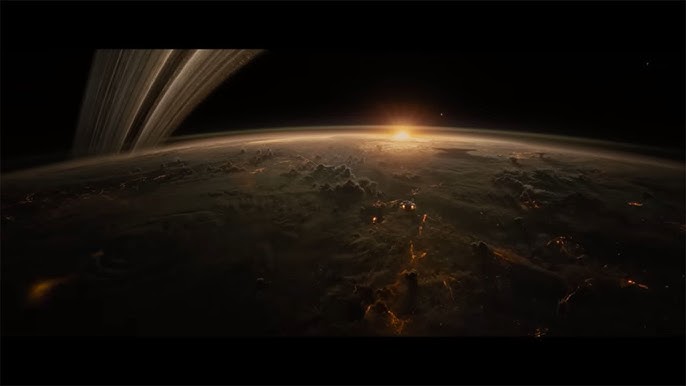
Ecocriticism looks at the relationships between humankind and nature; it reinterprets our place in the natural order of things, looking at how we live, where we live and how our decisions as a species impact upon the world around us. As such, science fiction and dystopia offers a rich source of ecocritical ideas: this seems particularly true of Fede Alvarez’s recent film Alien: Romulus (2024), coming as it does midway through the timeline of Alien (1979) and Aliens (1986), in a future where Earth – now a home planet in a network of other worlds – is often conspicuous by its absence. In terms of ecocriticism, this is key: if this critical perspective encourages us to consider our place on Earth, then the potential removal of humanity from Earth recontextualises that place, asking questions which are rarely directly addressed by the Aliens timeline, but remain important. Only Alien: Resurrection (1997) ever brings the audience anywhere near the home planet, and it remains a closed book, never seen other than from orbit, and never landed; it’s just another destination at risk during the xenomorph timeline. Other than that, its status has shifted and the implication seems to be that the broader universe offers new opportunities to start again – new opportunities, at least, for some.
Humanity has at least partly decamped, in this version of the universe, to a number of remote, inhospitable places which can only be accessed through the technology of hypersleep – in other words, being placed in a kind of stasis for periods of years while the craft makes its way to destinations light years away. But even so, the economic system being implemented throughout the universe is eminently recognisable. The Alien universe’s big hitter, the genuine antagonist which either deliberately or inadvertently drives all the events which unfold, is the pan-planetary Weyland-Yutani Corporation, a massive organisation which unfolds recognisable practices ones which we will recognise – only at a new scale. Its ideals are now age-old: to derive profit from the exploitation of resources on different worlds via the labour of indentured workers. It relies on the efforts of settlers, miners and soldiers; this hasn’t changed in centuries. Although the settler colonies are small, the implication seems to be that there are many of them, albeit all at incredible distance from one another, and therefore unable to leave, to organise or to easily communicate. These people are weak and vulnerable, living in places ill-fitted for human life. You could argue that the proliferation of the xenomorphs through Hadley’s Hope is possible because it is such a hostile environment for the settlers; dark, inhospitable, and clearly very poorly surveyed. The settlers do the terraforming, and take all the risks.
Jackson’s Star, the setting for Alien: Romulus, is another colony with a meagre population, wracked with industrial accidents, diseases and premature deaths. We discover that protagonist Rain’s parents have died because of conditions at the colony; one of the reasons she is willing to risk an escape is to avoid sharing their fate, when she finds out that she is about to be sent underground, too. But legitimate means of escape are denied, albeit in customarily soothing, customer-facing language. The Weyland-Yutani operative at the work office denies that Rain is coming to the end of her tenure, although Rain insists that she is. The very idea is a lie; Rain’s contract is updated whilst she is stood at the desk asking (and expecting) to be released. She, like all the others, is fully indentured and will never be permitted to leave. However, the woman thanks her in rehearsed language for her hard work on behalf of the company.
It’s hideously unfair – and only the tip of the iceberg, given what Weyland are doing with at least some of their profits and power. They are, and have always been, represented as cruel, corrupt overlords, framing ‘concern’ for their colonists as being about their welfare, when it is really an entirely economic concern, at least by this point in the Weyland universe timeline.
What Weyland is mining, what it is using these resources for, and/or to whom they sell their goods remain, for the most part, a mystery. But they certainly fund clandestine scientific research, getting past any human qualms about their operations by concealing the truth, outright lying, or using their own synthetics (or androids) to do the bulk of their dirty work, programming them with prime objectives which protect the interests of the company at any cost to expendable human life. It is presumably only because synthetics are costly to manufacture and maintain that Weyland bothers with human workers at all. In a game where the Queen takes all, we also get key synthetics in the timeline, as embodied by the coldly clinical Rook and later, by the more conscientiously-programmed Bishop, but the humans are always the pawns. Romulus is also interesting in how it brings us a flawed synthetic in Andy – an end-of-line model whose glitches come across like a cognitive impairment, and whose prime objective (to do what is best for Rain) makes him function like a loving big brother. However, with an ‘upgrade’, when he connects to the mainframe computer aboard the space station, his objective changes; he is a piece of Weyland kit after all, and this can – and does – override his usual state, shedding the tics and impairments to place Andy on a level with Rook, whose programming bids him to continue with the mission, even though the station’s fleeting encounter with the xenomorph life cycle has turned it literally inside out.

The work is valuable (to Weyland) for reasons other than pure curiosity. This raises a question which has hung over the Alien series since its inception. Rook, or more accurately, Ash was originally instructed to preserve the xenomorph; perhaps, at this point, there was no clear mission attached to this, only a desire to find out more. However, by the time Aliens unfolds (albeit we now understand this to be later than the events in Romulus) the implication seems to be that the xenomorph could be useful for a military or a defence purpose – Weyland wants to sneak two embryos past military quarantine, thereafter to examine their potential. You can infer a certain purpose here. But this has always seemed strange. Surely, there could be no conventional military purpose for this lifeform, a creature which cannot be ‘taught tricks’, as claimed in Alien: Resurrection – other than to display some rudimentary learning which it then uses to escape and to kill its supposed masters. Other questions occur: what sort of enemy would require the xenomorph to fight it? How could they be controlled in terms of their population? How do you fight with a bio-weapon you can’t turn off?
In Alvarez’s screenplay, Rook suggests a more plausible reason that Weyland is so keen to control the xenomorphs and will risk anything to preserve the specimens. In stating that its intensely resilient DNA is a malleable tool which can perhaps be used to reverse-engineer the colonists, making them into better producers and workers, less susceptible to illness and injury, Weyland reveals that its motivations are, again, purely economic. And again, Rook is prepared to sacrifice anything to fulfil his mission, including the manipulation of the few humans he encounters on the space station. Why not, if experimental models present themselves? Human life, always susceptible in environments like the ones selected by Weyland to best generate profitable materials, is also fodder for scientific method, come what may.
In ecocritical terms, the xenomorphs themselves generate big questions about the relationship between species and environment. The xenomorph is a lifeform in many respects like any other lifeform: reproducing, nesting, responding to stimuli, attacking perceived threats. However, with a lifecycle which destroys its host organisms in days (or far quicker, even implausibly so, in Romulus) it would leave itself with no further means to reproduce (or presumably, feed itself either) after a comparatively short amount of time. Perhaps humans just provide particularly tantalising hosts, even if the xenomorphs are adaptable – any mammalian life seems suitable – though Romulus seems to suggest that the creature can even hibernate in space and be resurrected later. Whatever else the xenomorph is, it’s resilient and it is adaptable. It also thrives on the kinds of interplanetary travel and colonisation promoted by Weyland to find its new hosts and habitats; the corporation facilitates the proliferation of xenomorphs, whether wittingly or otherwise. But it is very telling that, whatever this organism is, whatever it does and however harmful it is, Weyland see in it a higher purpose which serves them. They are only interested in restricting the creature’s progress where it sees a reason for this – where it can be categorised, stored and examined, and then exploited, so that (we now glean) human workers may be exploited further.
Rain and her friends, with all of their flaws, their desperation and their ambitions are a foil to this higher purpose. In seeking to survive and to progress beyond the remit of Weyland’s control, seeking a planet more amenable to their own manner of existence, they fight back against the corporate control being exerted. They are individuals, working against a hostile organism and a conglomerate seeking to exploit that organism, too, to further the mistreatment of humans, though ostensibly to ‘help’ them, using obfuscation and weasel words to conceal their actions.

It is interesting that Rain’s escape is symbolised by the simple idea of watching the sun rise. The desire to ‘see the sun’ is a key driver behind her risky, almost fatal attempts to escape. Arguably, given the human requirement for exposure to the sun to remain healthy (such as through the manufacture of Vitamin D) the planet which hosts Jackson’s Star is wholly inappropriate for human life. This doesn’t deter Weyland-Yutani. Rain is prepared to risk everything to see the sun; she wishes to travel to a remote world where the sun does rise. She doesn’t expect to be free from labour when she gets there; she just harbours this simple wish, one which has a long literary precedent as a symbol of really ‘seeing’, or engaging with nature, as Ralph Waldo Emerson suggests when he says “most persons do not see the sun. At least they have a very superficial seeing. The sun illuminates only the eye of the man, but shines into the eye and the heart of the child” (1). The sun – a sun – maybe any sun – represents natural order, natural rhythm, normality and beauty – even if, as is totally possible in Rain’s case, she has never experienced that natural order as part of her own life.
But she is human after all; she has been encultured to believe in this natural order and in how beautiful it is – finally seeing a tantalising glimpse of this sun when she first travels in the ersatz mining vessel to a point above the atmosphere. It has a key emotional impact on her, staying with her throughout the narrative arc, even if – thanks to the sci-fi framework of the film – she will be looking at a different sun, if she finally reaches her destination. Other characters, too, share her motivation. It’s poignant in its simplicity, and shows what they lack (and what we, as an audience, perhaps fail to appreciate). There is much within Alien: Romulus which, fantastical or not, seems cautionary, with its continuing story of over-powerful corporations which devalue people and worlds, but at the end of the film, we may hope that Rain finally gets her wish to see the sun rise every day, and perhaps we may see our own circumstances – and our own place on our planet – in a different way, too.
Ralph Waldo Emerson, “Nature,” in The Selected Writings of Ralph Waldo Emerson, ed. Brooks Atkinson (New York: Random House, 1968), 6.
